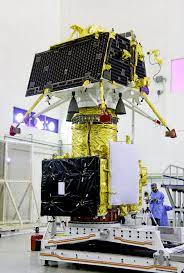Chandrayaan-3 the mission to the moon by India was launched from the Satish Dhawan Space Centre in Sriharikota Range (SDSC SHAR), Andhra Pradesh, by the Indian Space Research Organization (ISRO) on 14 July 2023. It was on a mission to utilize new technologies and achieve a soft landing on another celestial body, ‘the moon, for the very first time after two previous missions to the moon, such as Chandrayan-2 and Chandrayan-1

Table of Contents
Objectives:-
The objectives of the Chandrayaan-3 mission were a safe and soft landing on the lunar surface. It is the third Indian mission to the moon to explore more about the south pole under the Indian Space Research Organization’s Chandrayaan program. It consists of a lander called Vikram and a rover called Pragyan, similar to those of Chandrayaan-2.

Other moon missions of india
Chandrayaan-2 was launched on July 22, 2019. Chandrayaan-2 was a partially successful mission, as it failed to soft-land on the moon’s surface because of a chain of events triggered by a valve’s failure to reduce flow into the engines. However, Chandrayaan 1, which was launched on October 22, 2008, was a successful mission. It was an attempt to put a spacecraft into a precise orbit around the moon that was a complete success.
** Chandrayaan-3 cost Rs 615 crore (nearly $75 million), which is very little as compared to other countries’ moon missions.
** The launching vehicle utilized for Chandrayaan-3 is LVM3 M4, which will place the integrated module in an Elliptic Parking Orbit (EPO) of size 170 x 36500 km.
The lander module of Chandrayaan 3 landed on the moon’s surface on August 23 (06:04 PM), and thus India became the fourth country in the world to have mastered the technology of soft landing on the surface of the moon after the US, China, and the Soviet Union. This is a big achievement for the scientists at ISRO as well as the whole nation, bringing pride and glory to the nation’s prestige in the field of science and technology advancement. And by doing so, India created history by becoming the first and only country to land at the south pole of the moon.

Agencies participated
The spacecraft Chandrayaan-3 (CH-3) is the result of a collaborative endeavour involving partnerships with other space agencies, contributions from external sources, and the expertise and scientists of ISRO itself.
- The CH-3 lander carries an auxiliary instrument known as ‘Laser Retroreflector Array (LRA)’ which was designed by the National Aeronautics and Space Administration (NASA) of the USA. This lightweight structure with eight Retroreflectors Array acts as a long-term geodetic station and a location marker on the lunar surface.
- Other Ground stations of ISRO are located in Brunei, Indonesia, and Mauritius.
- European Space Agency (ESA), located in French Guiana, the UK, & Australia;
- NASA is located in the USA, Spain, and Australia.
- The Swedish Space Corporation (SSC), located in Chile and the USA, provides the required support for tracking, deep space communication, and navigation.
Tech Specification of Chandrayaan-3
A spacecraft carries payloads or scientific instruments into space. When it revolves around Earth or another celestial body, it is referred to as an artificial satellite. CH-3 consists of a lander, which is designed to softly touch down on the moon’s surface, and a rover, which is ready to explore the lunar terrain after the lander lands on the lunar surface. To carry the lander and rover toward the moon, CH-3 incorporates a propulsion module (PM).
Payloads and their scientific instruments of Chandrarayan-3
The spacecraft carries a total of seven scientific instruments.
The lander carries four instruments:
- ILSA, a seismometer, developed by LEOS.
- RAMBHA-LP, a Langmuir Probe, – designed, realized, and delivered by the Space Physics Laboratory (SPL/VSSC).
- CHASTE, a thermal probe, – designed, realized, and delivered by SPL/VSSC.
- LRA, a Retroreflector from NASA.
The rover has two instruments:
- APXS, an X-ray spectrometer, provided by the Physical Research Laboratory, PRL.
- LIBS, a laser-based spectrometer, provided by LEOS.
The propulsion module (PM) has:
- SHAPE (a spectro-polarimeter) instrument, developed by URSC.
Major scientific experiments planned after the successful landing of the Landers on the Moon’s surface include the following:
- Study of vibrations on the lunar surface due to seismic events and/or due to the impact of meteorites, rover movement, etc.
- Trace of a plasma environment near the surface.
- Temperature and thermal conductivity up to a depth of 10 cm below the surface.
- Composition and make-up of “in and around the landing site”.
- Spectral signatures of the Earth from lunar orbit.






